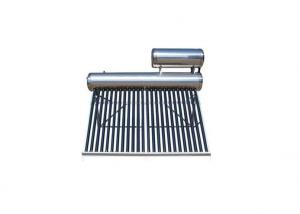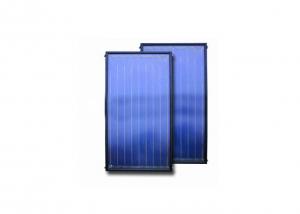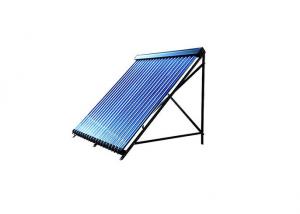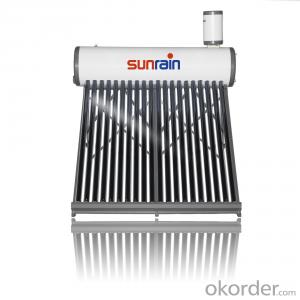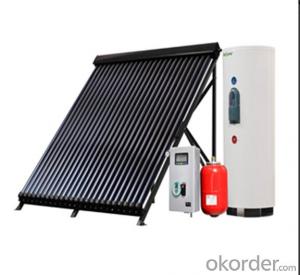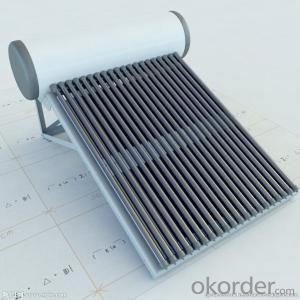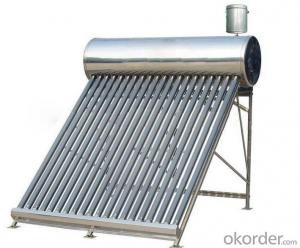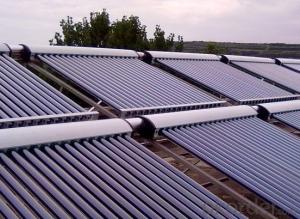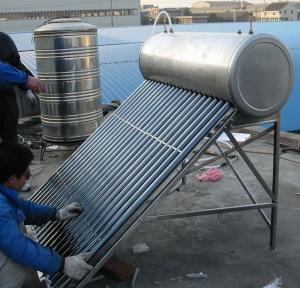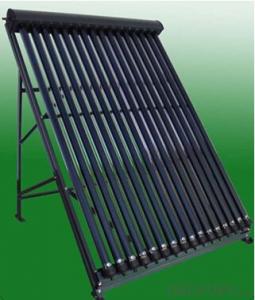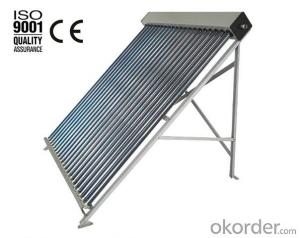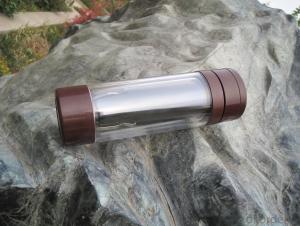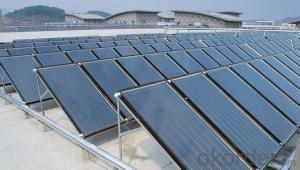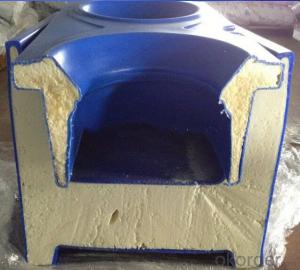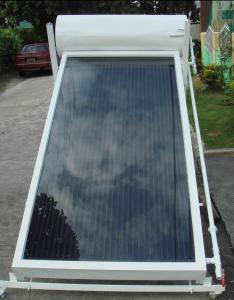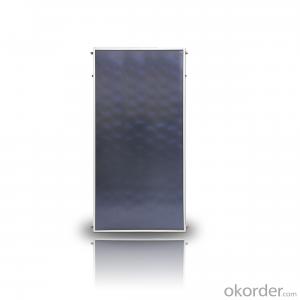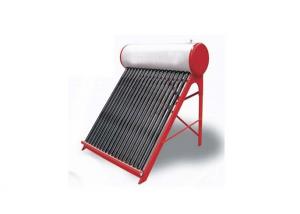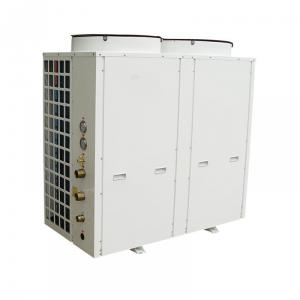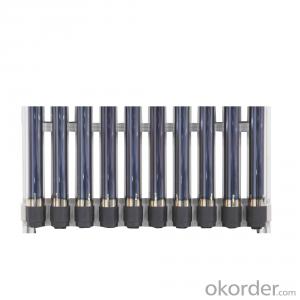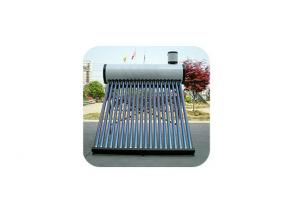New Solar Water Heater for Horse Trough
- Loading Port:
- China Main Port
- Payment Terms:
- TT or LC
- Min Order Qty:
- 1 Set set
- Supply Capability:
- 5000 Sets per Month set/month
OKorder Service Pledge
Quality Product, Order Online Tracking, Timely Delivery
OKorder Financial Service
Credit Rating, Credit Services, Credit Purchasing
You Might Also Like
2013 New solar water heater /2 water tank/assitant tankTake order even 1 pcs. paypal acceptable.
| Non-pressurized Solar Water Heater TECHNICAL DATA | |||||||
| WATER STORAGE TANKS SPECIFICATION | |||||||
| Material of out tank | High quality Painted steel/ Stainless steel. | ||||||
| Material of inner tank | Food grade SUS304-2B stainless steel. | ||||||
| Tank insulating layer | Imported polyurethane can conserve the heat for maximum 72 hours | ||||||
| Inlet and outlet hole | Male G 1/2 | ||||||
| Tank size | 420,460,470,475,480,500mm or Customer demand | ||||||
| Welding: | Argon arc welding | ||||||
| EVACUATED VACUUM TUBES SPECIFICATION | |||||||
| Tube structure | All-glass double deck co-axial structure | ||||||
| Glass material | High borosilicate 3.3 glass | ||||||
| Outer tube dia. & thickness | Ø58±0.7mm; Glass thickness 1.6±0.15mm | ||||||
| Inner tube dia.& thickness | Ø47±0.7mm; Glass thickness 1.6±0.15mm | ||||||
| Tube size | 58*1800mm | ||||||
| Absorptive coating property | Structure | AL/AL-ALN(H)/AL-ALN(L)/ALN or Cu/SS-ALN(H)/SS-ALN(L)/ALN | |||||
| Sediment method | Single target or Three targets - magnetron sputtering plating | ||||||
| Specific absorption | 0.90-0.93(AM1.5) / 0.93-0.96(AM1.5) | ||||||
| Emission ratio | 0.05-0.075(800C±50C) / 0.04-0.06(800C±50C) | ||||||
| Solar irradiation for obtaining a preset water temperature | Φ=58 H≤4.7MJ/m² | H=4.1-4.4MJ/m² / H=3.7-4.2MJ/m² | |||||
| Vacuum tightness | 5.0×10¯³ Pa | ||||||
| Idle sunning property parameters | 220-260 m².C/KW / 260-300 m².C/KW | ||||||
| Average heat loss coefficient | ULT=0.6~0.7W/(M2.0C) / ULT=0.4~0.6W/(M2.0C) | ||||||
| Resistant Hail | ≤25mm | ||||||
| Useful life | 15 years | ||||||
| BRACKET | |||||||
| Bracket: | Stronger galvanized steel / Stainless steel/aluminium alloy | ||||||
| Bracket angle: | 0,18,22,38,45 optional, pitched roof, flat roof optional. | ||||||
| Fastening pieces: | Made of zinc-coated stainless steel.. | ||||||
| MODEL No. | Tube Size | Tube No. | Tank Capacity | Aperture Area | Reommending for family | Load Qty 20GP/40HQ | |
| Dia.*L | ( m2) | (m3) | (sets) | ||||
| JXNP-58-10 | 58*1800mm | 10 | 100 | 0.93 | 2 | 77/184 | |
| JXNP-58-12 | 58*1800mm | 12 | 120 | 1.11 | 2 | 64/153 | |
| JXNP-58-15 | 58*1800mm | 15 | 150 | 1.39 | 3 | 52/123 | |
| JXNP-58-18 | 58*1800mm | 18 | 180 | 1.67 | 4 | 43/102 | |
| JXNP-58-20 | 58*1800mm | 20 | 200 | 1.86 | 5 | 39/92 | |
| JXNP-58-24 | 58*1800mm | 24 | 240 | 2.23 | 6 | 32/77 | |
| JXNP-58-30 | 58*1800mm | 30 | 300 | 2.79 | 7 | 26/61 | |
| JXNP-58-36 | 58*1800mm | 36 | 360 | 3.34 | 8 | 21/51 | |
- Q: How to use solar water heater controller
- Features: automatic constant temperature water, replenishment, Sheung Shui, water temperature and water level digital color display, using humanized design, with low pressure water level, preset mode, timing control, manual control, automatic anti overflow, high temperature protection and other main functions, the use of more convenient, more secure and more practical.
- Q: Solar water heater hot water pipe why burst
- Hot water pipe burst of solar water heater:1, solar water tank without water, vacuum tube temperature during the day is higher, if the water at this time, due to the temperature difference is too large tube, the most likely.
- Q: Can a solar water heater be used in areas with restrictions on rooftop installations?
- Yes, a solar water heater can still be used in areas with restrictions on rooftop installations. In such cases, alternative installation options can be explored, such as ground-mounted systems or wall-mounted systems. These options allow for the utilization of solar energy without infringing on the specific restrictions placed on rooftop installations.
- Q: How does a solar water heater contribute to reducing carbon emissions?
- A solar water heater reduces carbon emissions by utilizing the sun's energy to heat water, eliminating the need for traditional fossil fuel-based heating methods. This renewable energy source significantly reduces the reliance on non-renewable energy sources, such as coal or natural gas, which release carbon dioxide when burned. By using solar power, a solar water heater helps to mitigate greenhouse gas emissions and contributes to a cleaner and more sustainable environment.
- Q: Can a solar water heater be used in areas with limited space for installation?
- Yes, a solar water heater can be used in areas with limited space for installation. There are compact and space-saving models available that can be installed on rooftops, balconies, or even walls. Additionally, some solar water heaters come with flexible installation options, allowing for efficient utilization of available space.
- Q: There are usually three people in my family, then the Chinese lunar new year some relatives back, there may be 5 to 7 people or so, we have to sell 12 local sijimuge solar tube, to more than 1 thousand, if 7 people, buy 12 tube solar energy, enough? How many tubes to buy?
- This is the main consideration of the number of people in the home, and then consider the number of hot water in winter, it is recommended to buy 12 ---15 tube water heater.
- Q: What are the common repair issues with a solar water heater?
- Some common repair issues with a solar water heater include leaks in the system, malfunctioning sensors or controllers, faulty pumps or valves, and issues with the heat exchanger or storage tank. Additionally, mineral buildup or scaling can also affect the performance of the system and require maintenance or repair.
- Q: Can a solar water heater be used in areas with limited access to clean water?
- Yes, a solar water heater can still be used in areas with limited access to clean water. While the solar water heater is primarily responsible for heating the water, the availability and cleanliness of the water supply are separate issues. Therefore, even in areas with limited access to clean water, a solar water heater can still be used to heat the available water, helping to provide hot water for various purposes.
- Q: Are there any limitations on the size of a solar water heater?
- Yes, there are limitations on the size of a solar water heater. The size of a solar water heater is limited by the available space for installation, the amount of sunlight received in the location, and the capacity of the system to heat and store water. Additionally, larger solar water heaters may require more complex and expensive installation and maintenance.
- Q: Make a comparison between two brands of mulberry and Chery
- Second, liner thickness. The quality of the liner determines the life of the water heater, if the water tank, the water heater will be scrapped. Major brand manufacturers use thickness of not less than 0.5mm of SUS304 food grade stainless steel liner. Argon arc welding is adopted to ensure the service life can reach more than 15 years. Other brands of water heaters in the liner between 0.2mm-0.4mm, the use of a period of time there will be water leakage problem. Therefore, consumers in the purchase of products must ask the thickness of the liner. At the same time, but also beware of patch water tank, the water tank liner is made up of a number of scrap steel belt, the entire inner bladder welding as many as dozens of times. Such a water tank, not only poor quality, but also may cause damage to the health of consumers with bacteria.
Guided by business philosophy, our company has experienced success in the three historic periods, noted as brand building, diversification and globalization. It has long attached significance to innovation in satisfying the demands of worldwide consumers and realizing win-win performance between our company and our clients.
1. Manufacturer Overview
| Location | Zhejiang,China |
| Year Established | 2006 |
| Annual Output Value | |
| Main Markets | North America South America Eastern Europe Africa Oceania Mid East Western Europe Central America Domestic Market |
| Company Certifications | ISO9001:2008;CE;CCC |
2. Manufacturer Certificates
| a) Certification Name | |
| Range | |
| Reference | |
| Validity Period |
3. Manufacturer Capability
| a) Trade Capacity | |
| Nearest Port | SHANGHAI,NINGBO |
| Export Percentage | 71% - 80% |
| No.of Employees in Trade Department | 6-10 People |
| Language Spoken: | English, Chinese, Spanish, Portuguese, French, Russian |
| b) Factory Information | |
| Factory Size: | 5,000-10,000 square meters |
| No. of Production Lines | Above 10 |
| Contract Manufacturing | OEM Service Offered Design Service Offered Buyer Label Offered |
| Product Price Range | |
Send your message to us
New Solar Water Heater for Horse Trough
- Loading Port:
- China Main Port
- Payment Terms:
- TT or LC
- Min Order Qty:
- 1 Set set
- Supply Capability:
- 5000 Sets per Month set/month
OKorder Service Pledge
Quality Product, Order Online Tracking, Timely Delivery
OKorder Financial Service
Credit Rating, Credit Services, Credit Purchasing
Similar products
Hot products
Hot Searches
Related keywords
